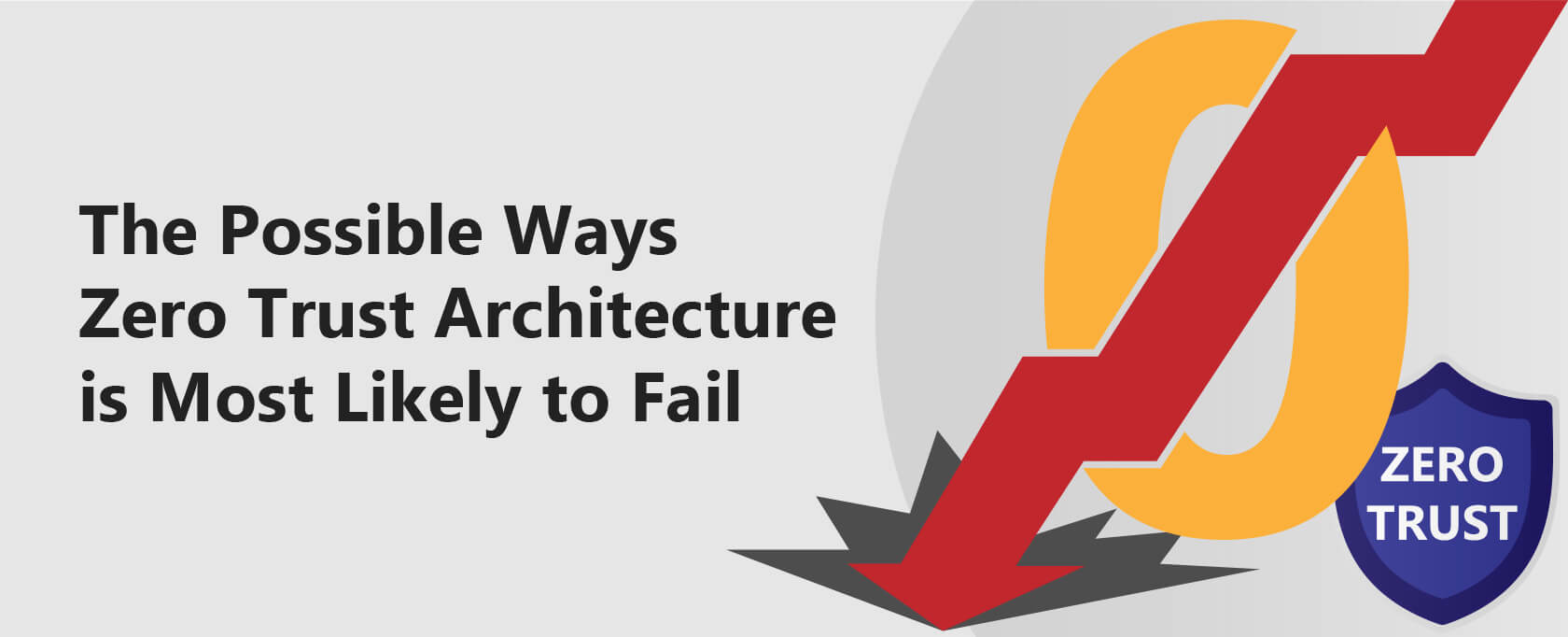The Possible Ways Zero Trust Architecture is Most Likely to Fail
The zero trust architecture is often seen as the ultimate, foolproof method of implementing information security.
It emerged as an all-in-one solution to several security issues, especially as organizations rapidly adopted cloud, DevOps, and IoT-based infrastructures.
The security model requires the creation of segmentation and network perimeters to ensure information security.
It redefines the architectural framework within a predefined network and creates a model of continuous evaluation of trust and authentication for access to sensitive information.
It implies that no user should be fully trusted even if they are a part of the network since everyone is vulnerable enough to be compromised.
Therefore, the user must get through identification and verification throughout the whole network instead of merely at the perimeters.
Security experts believe the zero-trust architecture to be the ultimate security model for preventing the dangers of hacking and insider threats.
However, several challenges with implementing the zero-trust architecture can also be viewed as loopholes for threat actors to exploit.
Central to this framework is the importance of network segmentation and boundary definition, combined with the continuous verification of trust and authentication before allowing access to sensitive data.
Implementing a zero trust strategy involves several key practices: deploying micro-segmentation, using multi-factor authentication, securing network endpoints, and following the Principle of Least Privilege.
However, adopting zero trust is not without challenges. Organizations must overcome the limitations of current technical infrastructure and legacy systems, manage the complexities of peer-to-peer communication, and transition from a siloed to a data-centric security approach.
Despite these obstacles, when properly implemented alongside other security measures, the zero trust framework can greatly bolster an organization’s protection against cyber threats.
Implementing the Zero Trust Model - What Does it Require?
Implementing the zero trust model into an organization goes beyond merely changing mindset and implementing data controls. IT security teams have to map and analyze the organization’s complete workflow architecture while looking into things like:
- The functions of each department
- Currently used software
- Information store and transferring methodologies
- Various access levels
- Common devices
An analysis of these components allows the security teams to define the network perimeters and access controls they need to integrate.
To ensure the smooth functioning of business events during these matters, most teams consider building a security model from scratch instead of adjusting the pre-existing one.
Security teams must develop a step-by-step strategy for building an excellent final security infrastructure with room for consistent modifications. While implementing the zero trust architecture, the key elements security teams often focus upon are:
Create micro-segmentation
The zero trust architecture relies on micro-segmentation. It implies breaking the security network structure into small zones with separate access to each part.
For example, a micro-segmentation of an information storage network might contain several zones with dedicated access points. Each access point has an independent authentication method so that only requested people or programs would have access to it.
Implement multi-factor authentication
Multifactor authentication is another crucial element upon which a significant portion of the zero trust architecture relies.
MFA is a multifactor security model requiring more than one authentication method, such as pin codes and biometric authentications.
Proper implementation of MFA accurately represents the foundation of the zero trust architecture: “never trust, always verify.”
Secure all network endpoints
Regarding zero trust, the devices are no exceptions to the rules, which is why it is best to implement identity-centric security methods even at endpoints.
It means that a device that becomes a part of the corporate network should first be integrated within the zero trust architecture to go through the recognition and verification process.
Practice the Principle of Least Privilege
The principle of least privilege or the PoLP is the practice of limiting access to applications, data, systems, processes, and devices to authorized users only.
Users under the PoLP principles are granted access to a particular resource or information if their job requires it. This limits the chances of data theft and breaches.
Main Problems with the Zero Trust Architecture
The zero-trust security model helps build a robust security framework within organizations. More so, with the recent rise in hybrid leading to cloud storage and file transfers, the zero-trust security model helps ensure data security.
However, several barriers exist to implementing and properly executing the zero-trust security architecture, which might ultimately cause the model to fail. Some of these issues are as follows:
Facing technical debt and legacy systems
Most organizations are not structured to be micro-segmented. While implementing the zero trust model, organizations have to consider the operations of least privilege, which involves identifying and dividing sensitive data into respective zones.
For that, they have to analyze the data available, understand its flows and then try to build a security model through micro-segmentation, which can be stressful and costly.
Whether designing from scratch or a pre-existing network security model, there remains a possibility of cracks within the architectural framework leaving room for other cyber attacks.
Moreover, the zero trust model requires several levels of authentication and authorization. The “never trust always authenticate” seems very professional in theory; however, it requires all actors to go through verification for access within the implementation.
While this may be effective, set organizations systems are not well-equipped to handle this access control due to the absence of the least privileged mindset.
The Peer-to-Peer Challenge
Peer-to-peer or P2P information exchange and communication methods have long since remained in use due to their effectiveness and ease.
However, the P2P method communicates through a decentralized method without micro-segmentation, which the zero-trust security model goes on par with. They share information with little or no verification.
This P2P communication is present in most operating systems and wireless mesh networks such as windows which are commonly part of the organization. Therefore, implementing zero trust with them is a challenge.
Becoming data-centric
Most organizations have a traditional framework containing silos of data, a blend of sensitive and less sensitive data.
Since the organizations didn’t follow the least privileged mindset, the combination of such data seemed practical with all the information shared with everyone regardless of their need.
Implementing a zero-trust architecture within a frenzied state of information would be challenging.
Analyzing and implementing verification and access control might prove costly and require a more significant architecture that would be too complex to build.
Final Words: Is Zero Trust Model Effective or Ineffective?
Despite its challenges, the zero trust model is the ideal model to resist data theft and insider threat challenges.
It allows robust security and helps ensure protection from some significant cyber security challenges organizations face today.
Therefore, a complete rejection of the zero trust architecture would be fruitless nonetheless.
The best approach is to ensure security by adequately implementing and integrating the model with other cyber security practices.


